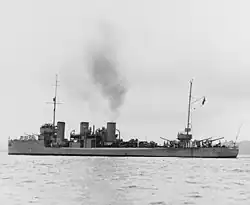BAP Almirante Guise (1933)
 BAP Almirante Guise in 1934
| |
| History | |
|---|---|
| Name | Avtroil |
| Builder | Reval Shipbuilding Company, Tallinn |
| Launched | 13 January 1915 |
| Completed | 1917 |
| Captured | 1918 by United Kingdom |
| Name | Lennuk |
| Acquired | 1918 from British |
| Fate | Sold to Peru, 1933 |
| Name | Almirante Guise |
| Commissioned | 1933 |
| Fate | Scrapped in 1954 |
| General characteristics (as built) | |
| Class & type | Izyaslav-class destroyer |
| Displacement | 1,390 long tons (1,410 t) |
| Length | 107 m (351 ft 1 in) |
| Beam | 9.5 m (31 ft 2 in) |
| Draught | 4.1 m (13 ft 5 in) |
| Installed power |
|
| Propulsion | 2 shafts; 2 steam turbines |
| Speed | 31 knots (57 km/h; 36 mph) |
| Range | 1,880 nmi (3,480 km; 2,160 mi) at 21 knots (39 km/h; 24 mph) (estimated) |
| Complement | 150 |
| Armament |
|
BAP Almirante Guise was a destroyer that served in the Russian, Estonian, and Peruvian navies from 1917 to 1954. She was a rebuilt type of the Izyaslav class. Originally named Avtroil while in Russian service, in 1918 she was captured by Royal Navy and handed over to Estonia where she was renamed Lennuk. The ship participated in the Estonian War of Independence, and served with the Estonian Navy until 1933, when she was sold to Peru where she was renamed Almirante Guise.
Design and description
The Izyaslav-class ships were designed to serve as flotilla leaders for the Novik-type destroyers.[1] The ships normally displaced 1,390 long tons (1,410 t)[2] and 1,570–1,590 long tons (1,600–1,620 t) at full load. They measured 107 meters (351 ft 1 in) long overall with a beam of 9.5 meters (31 ft 2 in), and a draft of 4.1 meters (13 ft 5 in). The Izyslavs were propelled by two steam turbines, each driving one propeller using steam from five Normand-Vulcan boilers. The turbines were designed to produce a total of 32,700 shaft horsepower (24,400 kW) for an intended maximum speed of 35 knots (65 km/h; 40 mph).[3] During the ships' sea trials, they only reached 31.7–31.8 knots (58.7–58.9 km/h; 36.5–36.6 mph) despite outputs of 34,975–35,700 shp (26,081–26,621 kW). The ships carried enough fuel oil to give them an estimated range of 1,880 nautical miles (3,480 km; 2,160 mi) at 21 knots (39 km/h; 24 mph). Their crew numbered 150.[2]
The Izyaslav-class ships were originally intended to have an armament of two single four-inch (102 mm) Pattern 1911 Obukhov guns, one each at the bow and stern, and a dozen 450-millimeter (17.7 in) torpedo tubes in six double mounts. The Naval General Staff changed this to four triple mounts once they became available and then decided to remove a torpedo mount in exchange for another four-inch gun at the stern on 20 August 1915 while the ships were still under construction. Another gun was ordered to be added on the forecastle on 25 May 1916. Izyaslav was completed with this gun armament, but her sister ships had another gun added on the stern in April 1917.[4] All of these guns were on the centerline and interfered with each other's movements.[5] Anti-aircraft defense was provided by a 2.5-inch (64 mm) Pattern 1916 anti-aircraft (AA) gun and a 3-inch (76 mm) Lender AA gun, both in single mounts amidships. The Izyaslavs were completed with one triple torpedo mount between the forward funnels and two mounts aft of the rear funnel. They could carry 80 M1912 naval mines. They were also fitted with a Barr and Stroud rangefinder and two 60-centimeter (24 in) searchlights.[3]
Service history
Following the collapse of the Russian Empire and the intervention into the Russian Civil War by the Allies, Avtroil, then under Bolshevik control, was captured by British cruisers and destroyers in the Baltic in December 1918.[6] The ship was transferred to Estonia, from whom she was purchased by the Peruvian Navy in 1933.[7] The ship was renamed Almirante Guise and served with the Peruvian navy until she was scrapped in 1954.[8]
Citations
References
![]() Media related to BAP Almirante Guise at Wikimedia Commons
Media related to BAP Almirante Guise at Wikimedia Commons
- Apalkov, Yu. V. (1996). Боевые корабли русского флота: 8.1914-10.1917г [Combat Ships of the Russian Fleet: 8.1914-10.1917] (in Russian). Saint Petersburg, Russia: ИНТЕК. ISBN 5-7559-0018-3.
- Breyer, Siegfried (1992). Soviet Warship Development: Volume 1: 1917–1937. London: Conway Maritime Press. ISBN 0-85177-604-3.
- Budzbon, Przemysław (1985). "Russia". In Gray, Randal (ed.). Conway's All the World's Fighting Ships 1906–1921. Annapolis, Maryland: Naval Institute Press. pp. 291–325. ISBN 0-85177-245-5.
- Scheina, Robert L. (1980). "Peru". In Chesneau, Roger (ed.). Conway's All the World's Fighting Ships 1922–1946. Greenwich, UK: Conway Maritime Press. pp. 423–424. ISBN 0-85177-146-7.
- Smigielski, Adam & Caruana, Joseph (1983). "Re: The Leithonian Navy". Warship International. XX (2): 116–117. ISSN 0043-0374.
- Twardowski, Marek (1980). "Estonia". In Chesneau, Roger (ed.). Conway's All the World's Fighting Ships 1922–1946. Greenwich, UK: Conway Maritime Press. pp. 351–353. ISBN 0-85177-146-7.
- Verstyuk, Anatoly & Gordeyev, Stanislav (2006). Корабли Минных дивизий. От "Новика" до "Гогланда" [Torpedo Division Ships: From Novik to Gogland] (in Russian). Moscow: Voennaya Kniga. ISBN 5-902863-10-4.